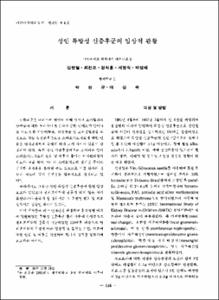KUMEL Repository
1. Journal Papers (연구논문)
1. School of Medicine (의과대학)
Dept. of Internal Medicine (내과학)
성인 특발성 신증후군의 임상적 관찰
- Keimyung Author(s)
- Kim, Hyun Chul; Park, Sung Bae; Park, Kwan Kyu; Lee, Sang Sook
- Journal Title
- 대한내과학회지
- Issued Date
- 1991
- Volume
- 40
- Issue
- 4
- Abstract
- A clinical observation was made on 150 adult patients with idiopathic nephrotic syndrome according to their histological types classified by light microscopic findings at Keimyung University Hospital for the past 6 years.
The majority of patients with nephrotic syndrome were young (mean age, 29.6), and the 80% of patients were less then 40 years old. The male-to-female ratio was 2.2:1 with male predominance.
Histopathologic findings of 150 renal biopsy tissues were classified into minimal change nephrotic syndrome (MCNS) 58%, focal glomerulosclerosis (16.7%), mem-branoproliferativeglomerulonephritis (10.0%), membranous nephropathy (9.3%), mesangial proliferative glomerulonephritis (3.3%), and chronic glomerulonephritis (2.7%).
The incidence of hypoalbuminemia and hypercholesterolemia was more frequent in MCNS than in other histological types. Microscopic hematuria (RBCi3 in HPF) was seen in 45% of MCNS and in 66% of other histological types. The time interval between the onset of symptoms and diagnosis was shorter in MCNS than in other histological types.
The average age at onset was youngest in MCNS (mean age, 25) and oldest in membranous nephropathy Microscopic hematuria, renal insufficiency, and hypocomplementemia was most frequently seen in membranoproliferative glomerulonephritis than in other histological types, and hypertension was most frequent in membranous nephropathy.
In reaction to steroid therapy, the highest response rate was seen in MCNS, which showed complete remission in 54%, partial remission in 21%, and no response in 24%. Meanwhile, those with other histological types showed only partial remission or no response at all. Sixty-six percent of patients with with MCNS experi-
enced remission in 4 weeks, and 93% of patients with MCNS went into remission within 8 weeks of steroid therapy. Major side effects of steroid therapy were Cushingoid appearance (27.1%), facial ance (10.2%), diabetes mellitus (8.5%), and peptic ulcer (3.4%), in decreasing order of frequency.
With cyclophosphamide therapy, complete remission was obtainded in 60% of patients with MCNS, while 20% of patients with MCNS had partial remission. In contrast, none of the patients with other histological types except mesangial proliferative glomerulonephritis showed complete remission.
During the follow-up period, the majority of patients with MCNS were in complete or partial remission, wherease patients with other histological types showed persistent nephrotic syndrome. Five patients died within 2 years after diagnosis, 2 from miliary tuberculosis and the other 3 from uremia, diabetic ketoacidosis, and suicide. Key Words: Nephrotic syndome, Steroid therapy. Cyclophosphamide
- Alternative Title
- Clinical Studies on the Adult Idiopathic Nephrotic Syndrome in Korea
- Publisher
- School of Medicine
- Citation
- 김현철 et al. (1991). 성인 특발성 신증후군의 임상적 관찰. 대한내과학회지, 40(4), 516–525.
- Type
- Article
- ISSN
- 1226-329x
- Appears in Collections:
- 1. School of Medicine (의과대학) > Dept. of Internal Medicine (내과학)
1. School of Medicine (의과대학) > Dept. of Pathology (병리학)
- 파일 목록
-
-
Download
 oak-bbb-00721.pdf
기타 데이터 / 728.02 kB / Adobe PDF
oak-bbb-00721.pdf
기타 데이터 / 728.02 kB / Adobe PDF
-
Items in Repository are protected by copyright, with all rights reserved, unless otherwise indicated.